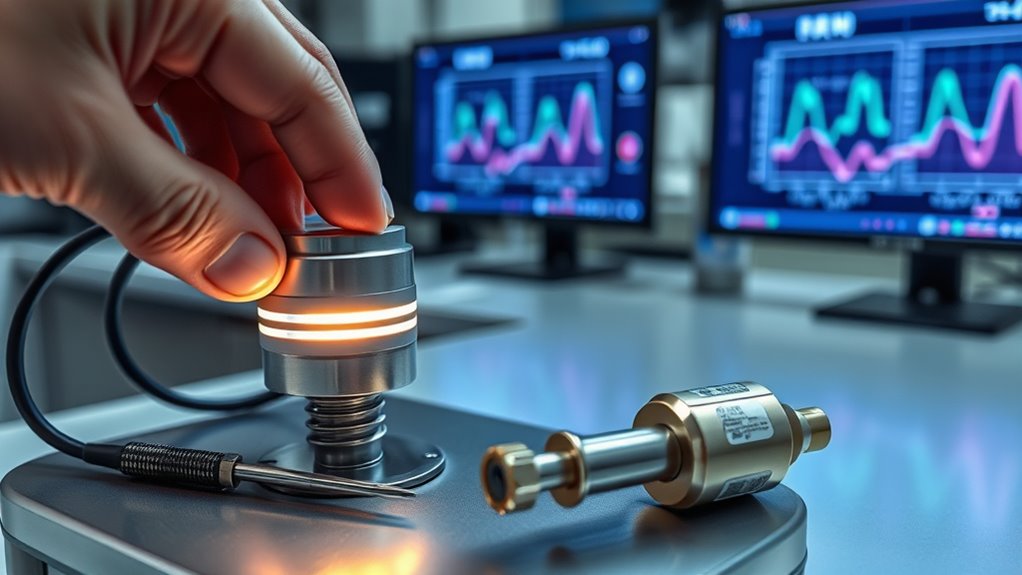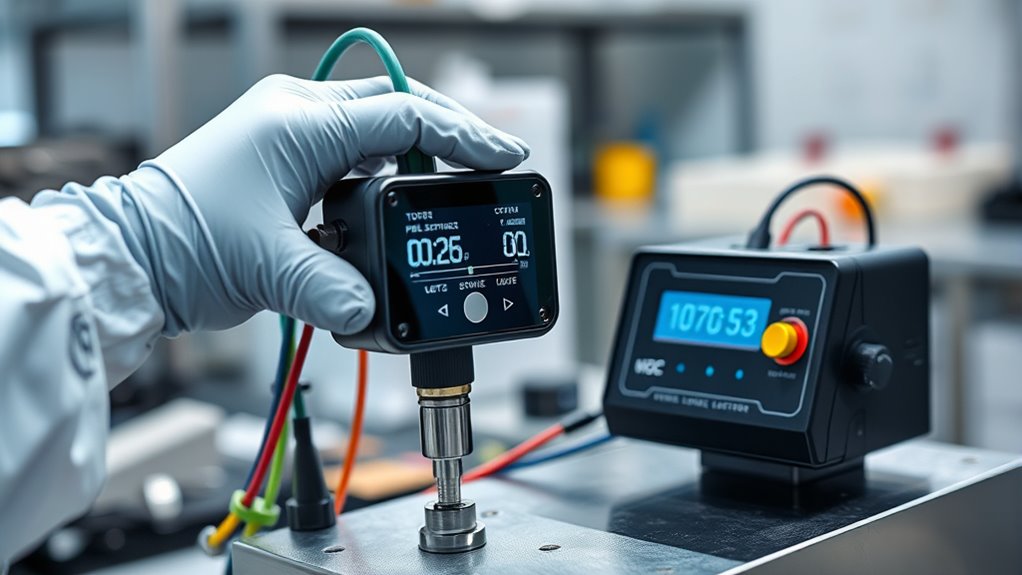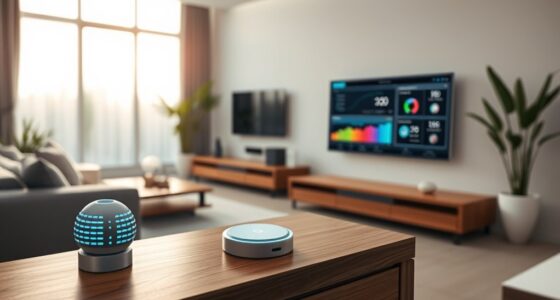To make certain your VOC sensor remains accurate, calibrate it regularly based on your environment and usage — weekly in contaminated areas or every few months in cleaner settings. Use a calibration gas with a known VOC concentration and follow the manufacturer’s instructions, making sure conditions are controlled. Keep detailed records of each calibration to track sensor performance. Continuing with proper calibration practices helps maintain reliable data and prolongs your sensor’s lifespan.
Key Takeaways
- Perform calibration regularly based on environment; weekly in high contamination areas, or every few months in cleaner settings.
- Use a known calibration gas or standard to expose the sensor and compare responses for accuracy.
- Follow manufacturer guidelines for calibration procedures, including sensor warm-up and controlled testing conditions.
- Keep detailed records of calibration dates, gas concentrations, and sensor responses for tracking performance.
- Regular calibration maintains sensor accuracy, prolongs lifespan, and ensures reliable VOC detection over time.

Calibrating VOC sensors is essential to guarantee accurate detection of volatile organic compounds in various environments. When you rely on these sensors to monitor air quality, ensuring their sensor accuracy becomes your top priority. Over time, sensors can drift from their original calibration, causing readings to become unreliable. That’s why understanding when and how to calibrate them is crucial for maintaining precise measurements.
Regular calibration of VOC sensors ensures accurate air quality monitoring and reliable data over time.
The key to effective calibration lies in knowing the appropriate calibration frequency. Depending on the environment and usage, sensors may require calibration more or less often. For instance, sensors used in highly contaminated industrial settings might need calibration weekly, while those in cleaner environments could go several months between calibrations. Regular calibration helps catch sensor drift early, preventing inaccurate readings that could lead to poor decision-making or overlooked hazards. You should establish a calibration schedule based on manufacturer recommendations and your specific application, but always stay vigilant for signs of sensor inaccuracies, such as unexpected readings or inconsistent data.
To calibrate your VOC sensors correctly, you need to follow a systematic process. Start by preparing a reference standard or calibration gas with a known concentration of VOCs. This ensures you have a reliable baseline to compare your sensor’s readings against. When performing calibration, make sure to operate the sensor in controlled conditions—stable temperature, humidity, and airflow—to avoid external factors from skewing results. Turn on the sensor and allow it to warm up if necessary, then expose it to the calibration gas. Observe the sensor’s response and compare it to the known concentration. If the readings don’t match within acceptable tolerances, adjust the sensor calibration settings accordingly, following the manufacturer’s instructions.
Remember, calibration isn’t a one-time task. Regularly scheduled calibrations, coupled with spot checks, help maintain sensor accuracy over time. You should also keep detailed records of each calibration, noting the date, the calibration gas concentration, and the results. This documentation is vital for troubleshooting and verifying ongoing sensor performance. If you notice persistent inaccuracies despite calibration, consider replacing the sensor or consulting with a professional. Proper calibration ensures that your VOC sensors deliver trustworthy data, enabling you to make informed decisions about air quality and safety in your environment.
In essence, maintaining calibration frequency and ensuring sensor accuracy are your best tools for reliable VOC detection. By staying proactive and methodical in your approach, you prevent drift from compromising your data, keeping your environment safer and your monitoring system trustworthy. Additionally, understanding the importance of sensor maintenance and regular checks can extend the lifespan of your equipment and improve overall detection reliability.
Frequently Asked Questions
How Often Should VOC Sensors Be Calibrated for Optimal Accuracy?
You should calibrate your VOC sensors regularly to guarantee ideal accuracy. The calibration frequency depends on your sensor’s lifespan and usage conditions, but typically it’s recommended every few months. Frequent calibration helps maintain sensor reliability, especially if you notice readings drifting or if the sensor operates in harsh environments. By sticking to a consistent calibration schedule, you’ll extend your sensor’s lifespan and keep your air quality measurements precise.
Can Environmental Factors Affect VOC Sensor Calibration Procedures?
It’s understandable to worry about environmental factors affecting your VOC sensor calibration. These factors, like temperature and humidity, can cause sensor drift, making calibration standards less reliable. To keep your readings accurate, you should regularly check how environmental conditions influence your sensor and adjust calibration procedures accordingly. Staying attentive guarantees your sensor maintains its precision, giving you peace of mind and reliable data at all times.
What Are the Signs Indicating a VOC Sensor Needs Recalibration?
You’ll notice sensor drift when VOC readings become inconsistent or don’t match expected levels, indicating the need for recalibration. Calibration indicators include sudden changes in sensor response, increased false alarms, or a decrease in accuracy over time. If your sensor’s readings seem off or fluctuate unexpectedly, it’s a clear sign you should recalibrate to guarantee reliable measurements. Regular checks help maintain sensor performance and accurate VOC detection.
Are There Different Calibration Methods for Various VOC Sensor Types?
You’ll find that different sensor types require specific calibration methods to guarantee accuracy. For example, electrochemical sensors often need gas calibration, while photoionization detectors might use standard VOC concentrations. Always check your sensor’s manual, as calibration methods vary based on sensor types. Regular calibration ensures your sensors provide reliable readings, helping you maintain safety and ideal operation. Adjust your calibration approach according to the specific sensor type you’re working with.
How Does Calibration Impact the Long-Term Reliability of VOC Sensors?
Think of calibration as your VOC sensor’s gentle tune-up, ensuring it stays on course over time. Regular calibration helps you catch sensor drift early, maintaining accuracy and reliability. When you don’t calibrate often enough, drift can quietly diminish your sensor’s performance, leading to less trustworthy readings. By sticking to a proper calibration frequency, you nurture your sensor’s longevity, keeping it dependable and precise for the long haul.
Conclusion
So, you thought your VOC sensor just needed a quick check now and then? Turns out, calibration isn’t a one-and-done deal. Ignore it, and you might be trusting faulty data, thinking your air is clean when it’s not. Ironically, the very device meant to protect you could be your silent culprit if uncalibrated. Keep up with calibration, or you might as well toss your sensor—because relying on it blindly is the real gamble.









